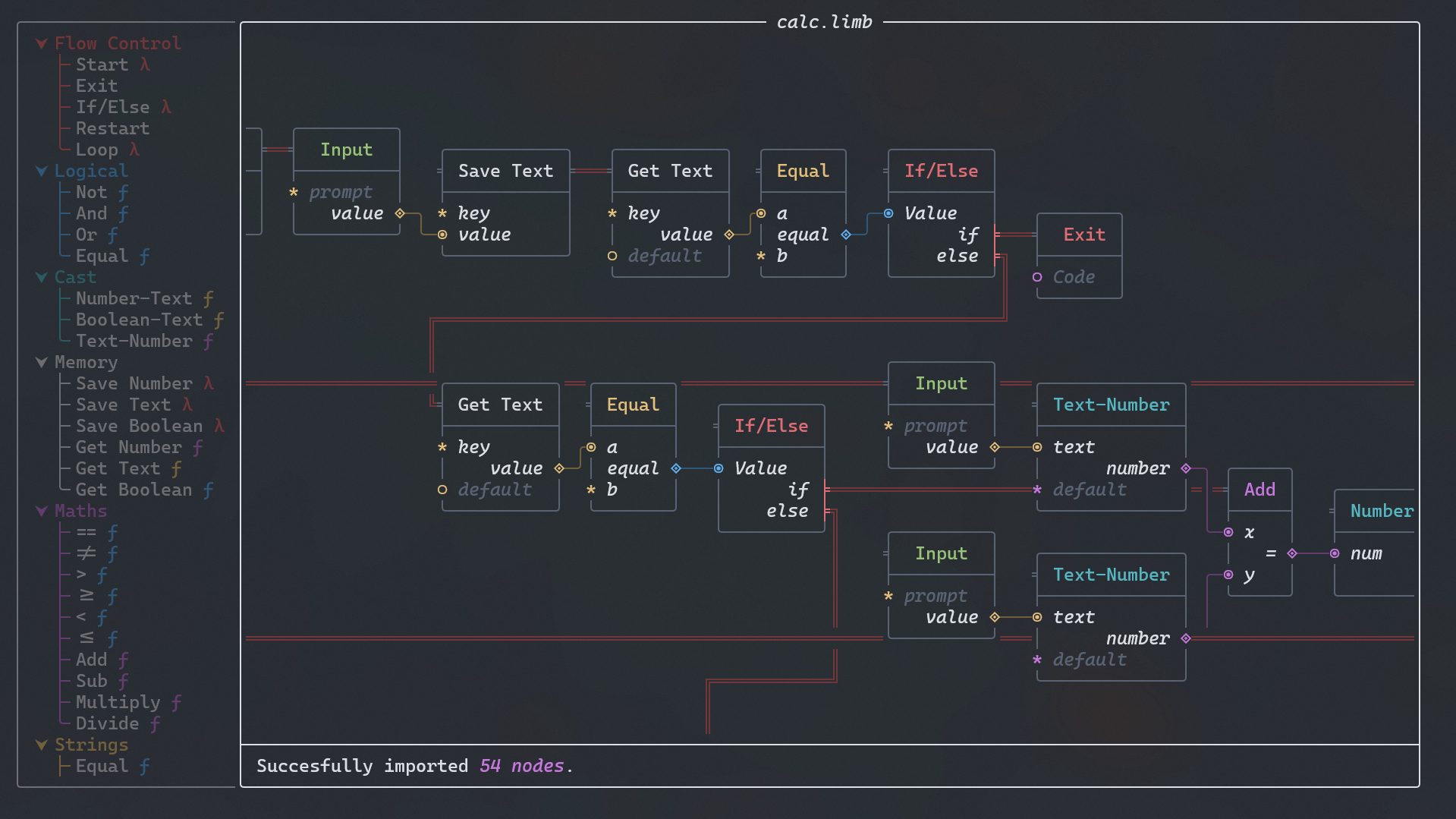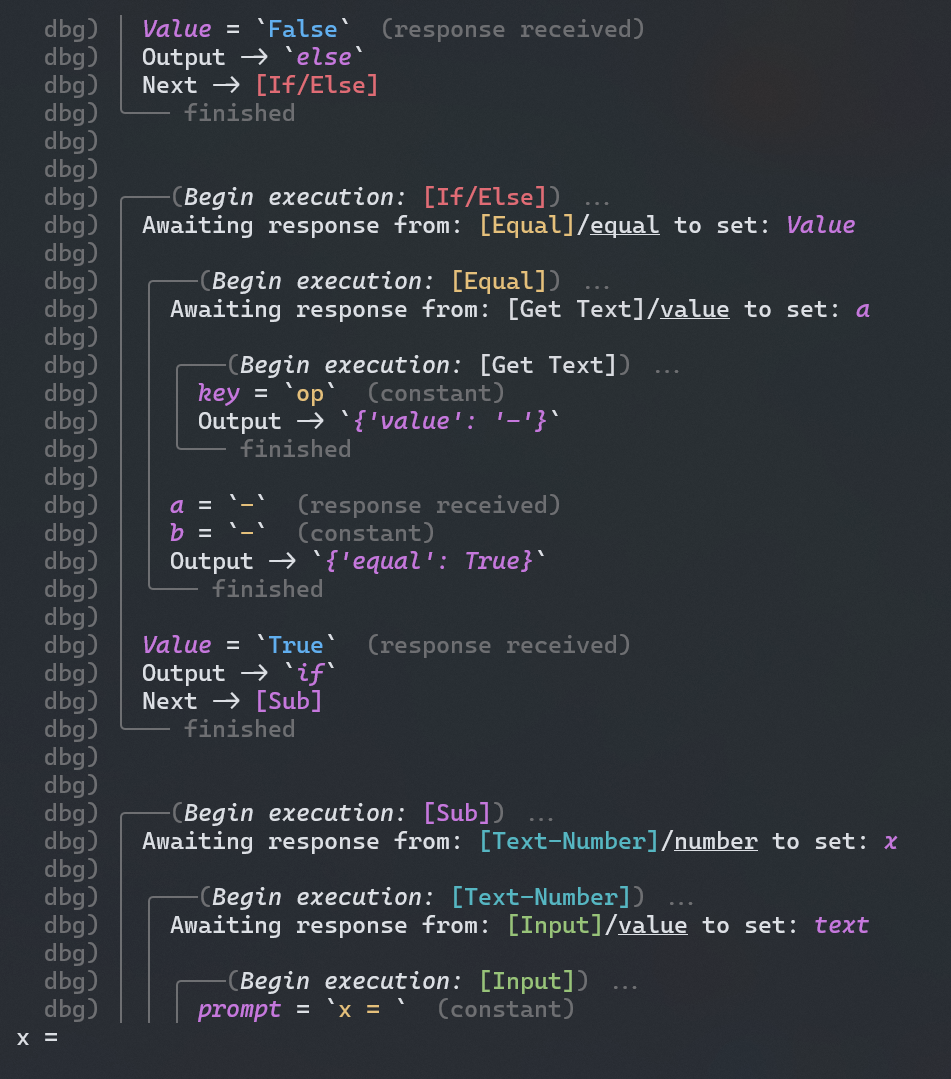Limbo is a programming environment that allows You to create simple programs using user friendly text interface in the terminal. There is no code, just node blocks with the input and output sources that You can connect together.
-
Ensure Python is installed and added to the PATH.
-
Clone the repository:
git clone https://github.com/7hebel/limbo.git
or download as a ZIP and unpack.
-
Install the required dependencies:
Open the terminal and navigate to the limbo's directory.
pip install -r requirements.txt
-
Run limbo:
py main.py (replace py with python3 on linux)
Import one of the templates located in the templates/ directory to check how program works.
py main.py templates/calc.limbSidebar is located on the left side of the app and contains all the available nodes that You can use in the program.
To move focus to the sidebar, press tab.
Navigate through the nodes using ↕ and ctrl + ↕ to skip a entire collection. Fold collections with ↔ and spawn new nodes with enter or space.
You can fold the entire sidebar using ctrl + b
Next to the node's title is located a output-based icon:
-
ƒ- Function node - returns a value (color represents data type) -
λ- Flow node - doesn't return any value but provides a Flow output. -
It occupies almost entire screen's space and is used to display and alter nodes.
You can shift the camera using ctrl + ←↑→↓ or move selected node with alt + ←↑→↓. To select a node, shift focus from other nodes using ←↑→↓. The algorithm will choose the closest node in given direction. Selected node's outline is colored and all wires connecting this node will be undimmed.
Spawn new nodes from sidebar. To enter a EDIT NODE mode press enter. Use ←↑→↓ to shift focus between the sources. To connect sources, press space on selected source and navigate to it's designated destination source in other node. Select the second node's source and press space again to connect the endpoints.
Remember that both sources must have same data type (color).
To set a constant value press c on the selected input source and type a value. Exit EDIT MODE with esc.
You can export workspace using ctrl + e and import another with ctrl + i. If there is no file associated with this workspace, You will be asked to provide name (path). Close the current workspace with ctrl + w.
Press F1 to run the current program starting from a START node. You can also compile a program to the .exe using F2 (it should take ~30s). There is also a built-in debugger (start with F12) that will run the interpreted version of the program but will also display a current state of the interpreter and the execution process of each individual node.
Below the main viewport, You can see the status bar displaying either a feedback from Your previous actions (like saving a file or altering a node) or keyboard shortcuts available in the current context.
Data type describes a type of data stored inside the source. They can be distinguished by a color and the name. There are 4 data types in Limbo.
-
TEXT(yellow) - Represents standard text provided by user or set as a constant value. -
NUMBER(purple) - Represents numbers and is used for a mathematical operations. (all numbers are treated as a floating-point) -
BOOLEAN(blue) - Logical value, either True or False. -
FLOW(red) - Special type not representing data but a runtime flow direction. It is used to point the next node that should be executed without passing any input data to it.
Use nodes from the Cast collection to switch data types.
It is not always possible to cast a text to a number, as text may contain invalid characters. Transformer will try to use all numbers and skip all the text characters but it still may fail. That's why You can provide the default value that will be used instead. When conversion fails and the default value is not provided, program will terminate with a ERROR status.
There is a entire collection of the nodes called Memory. It provides variable-like storage functionality to the program. At the start of the program, new memory jar is created. A memory jar is a key-value database. The RESTART node has a Save memory boolean input that if set to True, will not flush current memory state but start program with current memory jar.
All codes greater or equal 0 are considered as a success and negative codes means fail. The exit code defines a reason of exit.
Default codes:
-
0- OK -
-1- Runtime error. -
-2- Infinite recursion terminated. -
-3- Manual termination. -
10- Restart program -
11- Restart program and save memory
The RESTART node does the same thing as a EXIT with a code set to either 10 or 11.
You can export the current workspace state into a file written in the custom .limb format. Format uses byte symbols, so it might not be displayed correctly in all text editors (use hex editors).
📝 Format syntax.
LIMB\0 - File header.
\CAM6,34 - Camera position (x=6, y=34)
\NT,abc,xyz,9,23\0\Oabc/srcOut\>def/srcIn\0\0\Cabc/srcIn\>value\0 - Each node
\EOF - End of file.
Node format:
| Token | Description |
|---|---|
\N |
Node header |
T |
Is standard node? (T for True or F for False) |
, |
Value separator |
abc |
Node's instance ID |
, |
Value separator |
xyz |
Node's factory ID |
, |
Value separator |
9,23 |
Node's position in the format x=9, y=23 |
, |
Value separator |
\0 |
End of metadata section |
\O |
Output header |
abc |
Output node's ID (matches node instance ID above) |
/ |
Separator |
srcOut |
Name of output source (example: srcOut) |
\> |
Source pointer |
def |
Wire's target node's ID (example: def) |
/ |
Separator |
srcIn |
Name of source wire connects to (example: srcIn) |
\0 |
End of wire data |
\0 |
End of outputs section |
\C |
Constant values header |
abc/srcIn |
Node ID/source name in nodeID/sourceName format |
\> |
Pointer |
value |
Constant value (const example: value) |
\0 |
End of constant value |
(might contain multiple constants separated by \0 or no constants where file node ends on \C)


